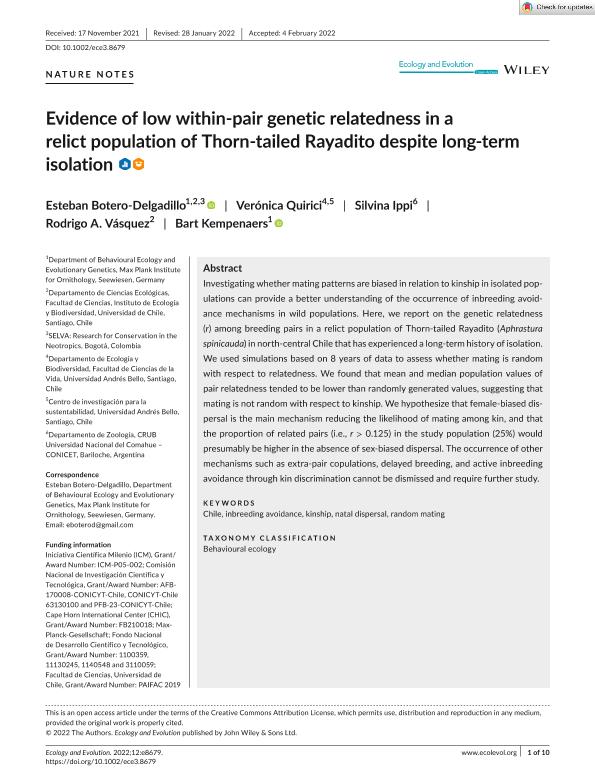Artículo
Evidence of low within‐pair genetic relatedness in a relict population of Thorn‐tailed Rayadito despite long‐term isolation
Botero Delgadillo, Esteban; Quirici, Verónica; Ippi, Silvina Graciela ; Vásquez, Rodrigo A.; Kempenaers, Bart
; Vásquez, Rodrigo A.; Kempenaers, Bart
 ; Vásquez, Rodrigo A.; Kempenaers, Bart
; Vásquez, Rodrigo A.; Kempenaers, Bart
Fecha de publicación:
03/2022
Editorial:
Wiley
Revista:
Ecology and Evolution
ISSN:
2045-7758
Idioma:
Inglés
Tipo de recurso:
Artículo publicado
Clasificación temática:
Resumen
Investigating whether mating patterns are biased in relation to kinship in isolated populations can provide a better understanding of the occurrence of inbreeding avoidance mechanisms in wild populations. Here, we report on the genetic relatedness (r) among breeding pairs in a relict population of Thorn-tailed Rayadito (Aphrastura spinicauda) in north-central Chile that has experienced a long-term history of isolation. We used simulations based on 8 years of data to assess whether mating is random with respect to relatedness. We found that mean and median population values of pair relatedness tended to be lower than randomly generated values, suggesting that mating is not random with respect to kinship. We hypothesize that female-biased dispersal is the main mechanism reducing the likelihood of mating among kin, and that the proportion of related pairs (i.e., r > 0.125) in the study population (25%) would presumably be higher in the absence of sex-biased dispersal. The occurrence of other mechanisms such as extra-pair copulations, delayed breeding, and active inbreeding avoidance through kin discrimination cannot be dismissed and require further study.
Palabras clave:
CHILE
,
INBREEDING AVOIDANCE
,
KINSHIP
,
NATAL DISPERSAL
,
RANDOM MATING
Archivos asociados
Licencia
Identificadores
Colecciones
Articulos(INIBIOMA)
Articulos de INST. DE INVEST.EN BIODIVERSIDAD Y MEDIOAMBIENTE
Articulos de INST. DE INVEST.EN BIODIVERSIDAD Y MEDIOAMBIENTE
Citación
Botero Delgadillo, Esteban; Quirici, Verónica; Ippi, Silvina Graciela; Vásquez, Rodrigo A.; Kempenaers, Bart; Evidence of low within‐pair genetic relatedness in a relict population of Thorn‐tailed Rayadito despite long‐term isolation; Wiley; Ecology and Evolution; 12; 3; 3-2022; 1-10
Compartir
Altmétricas



